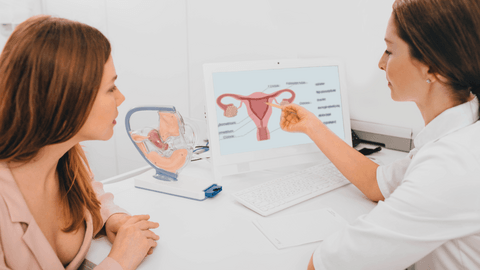Uterine Fibroids: Symptoms, Causes, Treatments
Uterine fibroids are noncancerous growths that develop in or around the uterus. They often appear during childbearing years and aren't associated with an increased risk of uterine cancer. The growths consist of fibrous tissue and muscle, and vary considerably in terms of size. Some fibroids are so tiny that the average person can't even see them, while other fibroids can grow big enough to distort and enlarge the uterus so much that they reach the rib cage and add weight.

Types of Uterine Fibroids
There are four different types of uterine fibroids, namely;
- Subserosal fibroids
- Submucosal fibroids
- Intramural fibroids
- Pedunculated fibroids
Subserosal fibroids are a variation of uterine fibroids that grow outside the uterus. Some of these fibroids are pedunculated, which means that they are attached by a narrow stalk. Although subserosal fibroids rarely pose any danger, they might still cause uncomfortable symptoms and affect the surrounding organ functions.
Submucosal fibroids on the other hand grow inside the uterus (womb), just beneath the surface of its lining, also known as endometrium. Even though this type of fibroids is the least common one, they often cause the most considerable problems, such as excessive uterine bleeding which in turn can lead to a lower count of red blood cells.
Intramural fibroids develop within the uterine wall, specifically within the muscular tissue. They commonly occur in the same region, often presenting as multiple growths. Intramural fibroids stand as the most prevalent type among uterine fibroids.
Finally, pedunculated fibroids are growths attached to the uterine wall by a stalk-like structure called a peduncle. They can develop both inside and outside the uterus, with the intrauterine variation termed a pedunculated submucosal fibroid and the extraneous form referred to as a pedunculated subserosal fibroid.
Symptoms of uterine fibroids can vary across individuals and depend on the type of fibroid. However, some of the common symptoms that indicate the presence of uterine fibroids include;
- menstrual periods lasting more than seven days;
- heavy bleeding during the menstrual cycle;
- constipation;
- pelvic pain;
- pelvic pressure;
- frequent urination;
- the urge to urinate frequently.
While these symptoms are frequently associated with uterine fibroids, experiencing them does not necessarily confirm their presence. However, you should contact your healthcare provider if you experience;
- heavy menstrual bleeding;
- pelvic pain;
- bleeding between periods;
- painful periods;
- anaemia.
Causes of Uterine Fibroids
The exact cause of fibroid development remains unknown. The processes controlling how and why fibroids grow and shrink over time are still unclear. However, both research and clinical experience point to potential factors contributing to uterine fibroids, including;
- Hormones such as oestrogen and progesterone. These hormones are produced by the ovaries. They cause the uterine lining to renew during the menstrual cycle and stimulate the abnormal growths of fibroids.
- Changes in genetic structure. Many fibroids may have DNA changes in genes that differ from those in normal uterine muscle cells.
- Pregnancy. During pregnancy the female body increases the production of hormones like oestrogen and progesterone, which can develop fibroids. However, indications show that after pregnancy, these fibroids can return to their regular size.
- Family history of fibroids. Studies indicate that if there's a family history of fibroids, there is a chance of inheriting the condition.
- Other growth factors. Certain substances that help the body maintain tissues could affect fibroid growth.
How are Uterine Fibroids Diagnosed?
Ultrasound
To diagnose the presence of uterine fibroids, the most commonly used test is an ultrasound scan. This procedure utilises a probe to generate high-frequency sound waves, producing an image of the interior of your body without causing pain. In order to diagnose fibroids, there are two different types of ultrasound scans;
- abdominal ultrasound - involves moving the ultrasound probe over the external area of your abdomen.
- transvaginal ultrasound - where the scan entails inserting a small ultrasound probe into your vagina.
If the produced images show any signs of fibroids, you may be referred to a gynaecologist for further tests.
Hysteroscopy
A hysteroscopy is a medical procedure where a small telescope is inserted into your uterus through the vagina and cervix. By undergoing such a procedure, the doctor is able to examine the womb and identify fibroids. While anaesthesia may be used to reduce any pain associated with the examination, most women do not require it. A hysteroscopy is helpful for finding submucosal fibroids.
Laparoscopy
During a laparoscopy, a small telescope with a light source and camera is inserted through the abdomen (tummy). The laparoscope is passed through the abdomen, allowing for examination of the organs and tissues inside the abdomen. Since the procedure requires a small cut, general anaesthetic is used.
Biopsy
In some cases, a small tissue sample, also known as a biopsy, can identify signs of uterine fibroids. The tissue sample may be removed during a hysteroscopy, and thereafter be closely examined under a microscope.
Uterine Fibroids Treatment Options
In most cases, uterine fibroids reduce or disappear as a woman enters menopause. There are two general treatment options: surgery or medically-induced menopause. Menopause treatment carries more significant risks.
Uterine fibroids usually shrink or disappear when women enter their menopause. However, there are some cases where the condition needs treatment. In these cases, there are several different treatment option;
- Myomectomy: a surgical procedure to remove the fibroids while preserving the uterus;
- Hysterectomy: a procedure to remove all or parts of the uterus
- Gn-RH (Gonadotropin-releasing hormone) agonists: temporarily shrink fibroids by suppressing hormone production
- Uterine artery embolization: a non-surgical procedure blocking blood flow to the fibroids;
- Surgery: repair or remove fibroids
- Hormone therapy: to alleviate symptoms
Uterine Fibroids and Fertility
The majority of women who have fibroids can still have children. However, it is possible that fibroids can be the cause of infertility problems or pregnancy loss. Fibroids may lead to pregnancy complications, which include:
- Placental abruption. Uterine fibroids can block the placenta and it will break away from the wall of the uterus
- Preterm delivery. Uterine contractions can cause early delivery.
- Foetal growth restriction. Large uterine fibroids can cause decreased space in the womb and it can prevent the foetus from growing.
- Breech position. The foetus can be unable to align for delivery due to the abnormal shape of the uterine cavity
- Miscarriage.

